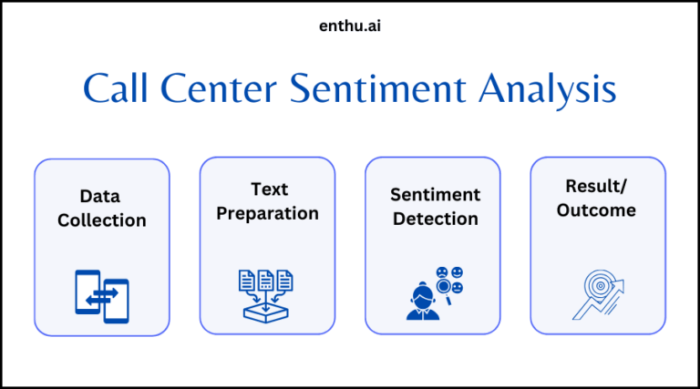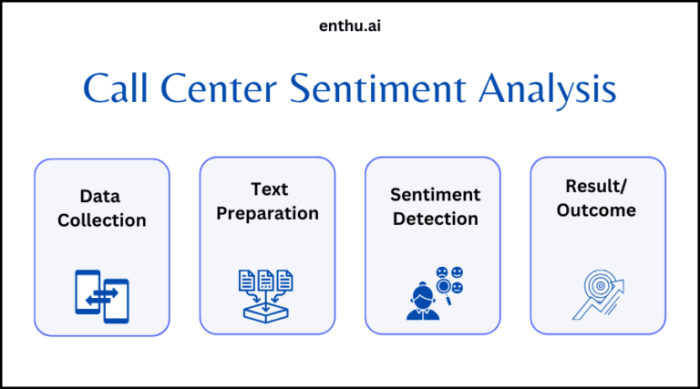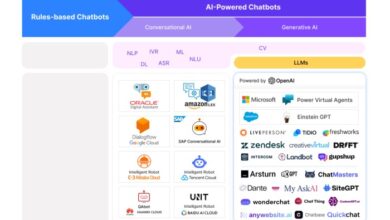
Call Center Sentiment Analysis: Understanding Customer Emotions
Call center sentiment analysis is a powerful tool that can help businesses understand the emotions and opinions of their customers. By analyzing the language used in customer interactions, businesses can gain valuable insights into what customers are thinking and feeling.
This information can then be used to improve customer service, resolve issues more effectively, and even drive product development.
Sentiment analysis can be applied to a variety of data sources, including call recordings, transcripts, emails, and social media posts. It utilizes natural language processing (NLP) and machine learning (ML) algorithms to identify patterns and trends in customer feedback.
This data can be used to identify areas where customer satisfaction is low, pinpoint specific issues that are causing frustration, and measure the impact of changes made to improve customer experience.
Call Center Sentiment Analysis
In the dynamic landscape of customer experience management, understanding customer emotions and feedback is paramount. Call center sentiment analysis emerges as a powerful tool for achieving this objective. By analyzing the emotional tone and sentiment expressed in customer interactions, call centers can gain valuable insights into customer satisfaction, identify areas for improvement, and enhance operational efficiency.
The Role of Sentiment Analysis in Understanding Customer Emotions and Feedback
Sentiment analysis, also known as opinion mining, is a natural language processing (NLP) technique that automatically extracts subjective information from text data. It involves analyzing the emotional tone, polarity (positive, negative, or neutral), and overall sentiment expressed in customer interactions.
In the context of call centers, sentiment analysis plays a crucial role in understanding customer emotions and feedback, providing valuable insights that can be leveraged to improve customer satisfaction and operational efficiency.
Examples of Sentiment Analysis Applications in Call Centers
Sentiment analysis can be applied in various ways to enhance customer experience and operational efficiency in call centers. Here are some examples:
- Real-time Sentiment Monitoring:Sentiment analysis can be used to monitor customer sentiment in real time during calls. By analyzing the tone of voice, s, and other verbal cues, call centers can identify customers who are experiencing frustration or dissatisfaction. This allows agents to intervene proactively, address concerns, and improve the overall customer experience.
- Call Quality Evaluation:Sentiment analysis can be used to evaluate the quality of customer interactions. By analyzing the sentiment expressed by customers during calls, call centers can identify agents who consistently provide positive experiences and those who need further training or coaching.
- Customer Feedback Analysis:Sentiment analysis can be applied to analyze customer feedback collected through surveys, emails, and social media. By identifying common themes and sentiments, call centers can gain a deeper understanding of customer needs and preferences, enabling them to tailor their services and improve overall customer satisfaction.
- Product and Service Improvement:Sentiment analysis can be used to identify areas where products or services are falling short of customer expectations. By analyzing customer feedback, call centers can identify specific features or aspects of their offerings that are causing dissatisfaction and prioritize improvements.
- Agent Training and Development:Sentiment analysis can be used to provide agents with real-time feedback on their performance. By analyzing the sentiment expressed by customers during calls, agents can identify areas where they can improve their communication skills, product knowledge, and customer service techniques.
Techniques for Call Center Sentiment Analysis
Analyzing sentiment in call center interactions is crucial for businesses to understand customer satisfaction, identify potential issues, and improve service quality. By leveraging the power of Natural Language Processing (NLP) and Machine Learning (ML) algorithms, call centers can automate sentiment analysis, gaining valuable insights from customer interactions.
Natural Language Processing (NLP)
NLP plays a fundamental role in sentiment analysis by enabling computers to understand and interpret human language. NLP techniques are used to extract meaningful information from call transcripts, including words, phrases, and their context. These techniques include:
- Tokenization: Breaking down text into individual words or units called tokens. For example, the sentence “I am happy with your service” would be tokenized as “I”, “am”, “happy”, “with”, “your”, “service”.
- Part-of-Speech (POS) Tagging: Identifying the grammatical role of each word in a sentence, such as noun, verb, adjective, or adverb. This helps to understand the relationships between words and their meaning.
- Named Entity Recognition (NER): Identifying and classifying named entities in text, such as people, organizations, locations, and dates. This can be helpful in identifying specific customer concerns or complaints.
- Sentiment Lexicons: Dictionaries containing words and their associated sentiment scores, ranging from positive to negative. These lexicons are used to assign sentiment scores to individual words and phrases in text.
Machine Learning (ML) Algorithms
ML algorithms are trained on large datasets of labeled call transcripts to learn patterns and predict sentiment. These algorithms can be used to classify sentiment into categories such as positive, negative, and neutral, or to identify specific emotions like anger, frustration, or satisfaction.
Popular ML algorithms for sentiment analysis include:
- Support Vector Machines (SVMs): A supervised learning algorithm that finds an optimal hyperplane to separate data points into different classes. SVMs are effective for classifying sentiment based on features extracted from text.
- Naive Bayes: A probabilistic algorithm that calculates the probability of a text belonging to a specific sentiment class based on the occurrence of words in the text. It is a simple and efficient algorithm for sentiment analysis.
- Deep Learning: A powerful technique that uses artificial neural networks to learn complex patterns from data. Deep learning models, such as recurrent neural networks (RNNs) and convolutional neural networks (CNNs), can achieve high accuracy in sentiment analysis.
Sentiment Analysis Models
Different sentiment analysis models employ various techniques to analyze sentiment. Common models include:
- Rule-based Models: These models rely on predefined rules and lexicons to classify sentiment. For example, a rule-based model might assign a positive sentiment score to sentences containing words like “happy” or “satisfied” and a negative score to sentences containing words like “unhappy” or “dissatisfied”.
- Statistical Models: These models use statistical methods, such as machine learning algorithms, to learn patterns from data and predict sentiment. Statistical models are typically more flexible and adaptable than rule-based models.
- Hybrid Models: These models combine rule-based and statistical approaches to leverage the strengths of both. For example, a hybrid model might use rule-based techniques to identify specific s and phrases and then use statistical models to classify sentiment based on the overall context.
Choosing the Right Model
The choice of sentiment analysis model depends on factors such as the complexity of the task, the availability of labeled data, and the desired level of accuracy. Rule-based models are suitable for simple tasks with limited data, while statistical and hybrid models are better suited for complex tasks with large datasets.
Data Collection and Preparation for Sentiment Analysis
The success of call center sentiment analysis heavily depends on the quality and quantity of data collected. This data serves as the foundation for training and evaluating sentiment analysis models, ultimately influencing the accuracy of insights derived.
Call center sentiment analysis is a powerful tool for understanding customer emotions, but it’s not always easy to capture the nuances of human interaction. That’s where the concept of “the ai in a jar” the ai in a jar comes in.
By thinking of AI as a contained entity, we can better grasp its limitations and potential, ultimately leading to more effective and nuanced sentiment analysis in call centers.
Sources of Data for Call Center Sentiment Analysis
The primary sources of data for call center sentiment analysis are call recordings, transcripts, and customer surveys. Each source provides unique perspectives on customer sentiment, allowing for a comprehensive understanding of customer experiences.
- Call Recordings: Call recordings capture the raw audio of customer interactions, providing a direct insight into the tone, emotion, and language used during the conversation. This data is particularly valuable for analyzing nonverbal cues and identifying subtle changes in customer sentiment.
- Transcripts: Call transcripts are textual representations of the recorded conversations, offering a structured format for analyzing the content of customer interactions. Transcripts are easier to process and analyze compared to raw audio recordings, making them suitable for automated sentiment analysis techniques.
- Customer Surveys: Customer surveys provide direct feedback from customers regarding their experiences with the call center. These surveys often include specific questions related to customer satisfaction, product quality, and overall service experience, offering valuable insights into customer sentiment.
Methods for Collecting Data
The methods used for collecting data for call center sentiment analysis are crucial for ensuring the quality and representativeness of the data.
- Automatic Recording: Call recording systems automatically capture all customer interactions, ensuring a complete dataset for analysis. This method is efficient and cost-effective, but it may require careful data management to handle large volumes of recordings.
- Manual Transcription: Transcripts can be manually created by human transcribers, ensuring high accuracy and capturing nuances in language. However, this method is time-consuming and costly, making it suitable for smaller datasets or specific analysis tasks.
- Automated Transcription: Speech recognition software can automatically transcribe call recordings, offering a faster and more cost-effective alternative to manual transcription. However, the accuracy of automated transcription can vary depending on the quality of the recordings and the complexity of the language used.
- Survey Platforms: Online survey platforms allow for the efficient collection of customer feedback through structured questionnaires. These platforms provide various question types and analysis tools, facilitating the collection and analysis of customer sentiment data.
Data Cleaning and Preprocessing
Before sentiment analysis can be performed, the collected data needs to be cleaned and preprocessed to remove noise and inconsistencies. This step is crucial for ensuring the accuracy and reliability of the analysis results.
- Removing Irrelevant Information: Irrelevant information, such as call center agent identifiers or timestamps, should be removed from the data to focus on the customer’s sentiment.
- Standardizing Text: Textual data should be standardized by converting all text to lowercase, removing punctuation marks, and correcting spelling errors. This ensures consistent processing and analysis of the text.
- Tokenization: Tokenization involves breaking down the text into individual words or phrases, known as tokens. This step is essential for analyzing the sentiment of individual words or phrases.
- Stop Word Removal: Stop words are common words like “the,” “a,” and “is” that do not contribute to the overall sentiment of the text. Removing these words helps to improve the efficiency and accuracy of sentiment analysis.
- Stemming and Lemmatization: Stemming and lemmatization are techniques used to reduce words to their root form, improving the accuracy of sentiment analysis by reducing the number of unique words. Stemming removes suffixes from words, while lemmatization considers the context of the word to determine its root form.
“Data cleaning and preprocessing are essential steps in call center sentiment analysis, ensuring the accuracy and reliability of the analysis results.”
Sentiment Analysis Metrics and Evaluation
Evaluating the performance of a sentiment analysis model is crucial to ensure its accuracy and reliability in providing valuable insights. This involves using specific metrics to assess how well the model predicts sentiment correctly.
Key Metrics for Evaluating Sentiment Analysis Performance, Call center sentiment analysis
Several metrics are used to evaluate sentiment analysis performance, each providing a different perspective on the model’s accuracy. These metrics are essential for understanding the model’s strengths and weaknesses and for making informed decisions about its application.
- Accuracy: This metric measures the overall percentage of correctly classified instances. It’s calculated by dividing the number of correct predictions by the total number of predictions. For example, if a model correctly predicts 90 out of 100 sentiments, its accuracy is 90%.
- Precision: This metric measures the proportion of correctly classified positive instances among all instances classified as positive. It’s calculated by dividing the number of true positives by the sum of true positives and false positives. For instance, if a model predicts 100 positive sentiments, and 80 of them are actually positive, its precision is 80%.
- Recall: This metric measures the proportion of correctly classified positive instances among all actual positive instances. It’s calculated by dividing the number of true positives by the sum of true positives and false negatives. For example, if there are 100 actual positive sentiments, and the model correctly identifies 80 of them, its recall is 80%.
- F1-Score: This metric is the harmonic mean of precision and recall, providing a balanced measure of the model’s performance. It’s calculated as 2 – (precision – recall) / (precision + recall). A higher F1-score indicates a better balance between precision and recall.
Measuring Accuracy, Precision, Recall, and F1-Score
These metrics are typically calculated using a confusion matrix, which is a table that summarizes the model’s predictions against the actual values. The confusion matrix helps visualize the different types of errors the model makes.
Call center sentiment analysis is crucial for understanding customer satisfaction and improving service. It’s like listening to the soundtrack of your business, and sometimes, those tunes can be a bit off-key. That’s where sentiment analysis comes in, helping you identify the highs and lows of customer experiences.
It’s like having a playlist of customer feedback, and you can even find some hidden gems, like Laura’s Palm Springs mini album, lauras palm springs mini album , which might inspire a new approach to your customer service strategy.
By analyzing the emotional tone of customer interactions, you can make informed decisions that lead to happier customers and a more successful business.
A confusion matrix for binary sentiment classification (positive or negative) would have the following structure:
| Predicted Positive | Predicted Negative | |
|---|---|---|
| Actual Positive | True Positive (TP) | False Negative (FN) |
| Actual Negative | False Positive (FP) | True Negative (TN) |
The metrics can then be calculated as follows:
- Accuracy= (TP + TN) / (TP + TN + FP + FN)
- Precision= TP / (TP + FP)
- Recall= TP / (TP + FN)
- F1-Score= 2 – (precision – recall) / (precision + recall)
Evaluating Model Performance on Different Datasets and Scenarios
It’s crucial to evaluate the model’s performance on various datasets and scenarios to assess its generalizability and robustness. This involves testing the model on data that is different from the training data, such as data from different domains, languages, or time periods.
This helps identify potential biases and limitations in the model.For instance, a sentiment analysis model trained on customer reviews for a specific product might perform poorly on reviews for a different product. Evaluating the model on reviews from diverse product categories helps assess its ability to generalize to new domains.Moreover, evaluating the model’s performance on different scenarios, such as different levels of sentiment intensity (e.g., strong positive vs.
weak positive) or different types of sentiment expressions (e.g., explicit vs. implicit), can provide valuable insights into its capabilities and limitations.
Applications of Call Center Sentiment Analysis

Sentiment analysis in call centers offers valuable insights into customer experiences, enabling businesses to enhance their operations and customer satisfaction. By analyzing the emotional tone of customer interactions, companies can identify areas for improvement, optimize agent performance, and proactively address emerging trends.
Identifying Customer Issues and Trends
Sentiment analysis helps pinpoint recurring customer issues and identify emerging trends by analyzing the emotions expressed in customer interactions. This enables businesses to proactively address concerns and adapt their services to meet evolving customer needs.
- Issue Identification:Sentiment analysis can detect negative sentiment associated with specific products, services, or processes, allowing companies to identify common pain points and address them promptly.
- Trend Analysis:By analyzing sentiment trends over time, businesses can identify emerging issues or shifts in customer preferences. For instance, a sudden surge in negative sentiment regarding a new feature might indicate a need for adjustments or further clarification.
Real-Time Monitoring of Customer Interactions
Real-time sentiment analysis empowers businesses to monitor customer interactions in real time, allowing for immediate interventions when negative sentiment arises. This proactive approach helps mitigate potential escalations and ensures a positive customer experience.
Call center sentiment analysis is all about understanding customer emotions, and sometimes, it feels like a puzzle. You’re trying to piece together clues from conversations to get a bigger picture, much like seeing the transformation of a space, like Laura’s front dining room before and after.
The before-and-after reveals a clear shift in style and functionality, and with sentiment analysis, we uncover the customer journey’s emotional evolution, helping businesses refine their strategies and deliver better experiences.
- Early Intervention:By analyzing sentiment in real time, call centers can identify customers experiencing frustration or dissatisfaction. This enables agents to intervene promptly, offering assistance or addressing concerns before the situation escalates.
- Agent Support:Real-time sentiment analysis can provide agents with valuable insights into the emotional state of customers, allowing them to tailor their communication style and approach accordingly. For example, an agent might adjust their tone or provide additional support if they detect high levels of frustration.
Improving Agent Performance and Training
Sentiment analysis provides valuable insights into agent performance, enabling companies to identify areas for improvement and tailor training programs to address specific needs. This data-driven approach helps optimize agent performance and enhance overall customer satisfaction.
- Performance Evaluation:Sentiment analysis can be used to evaluate agent performance based on customer sentiment. This allows companies to identify top-performing agents and areas where training might be needed.
- Training Enhancement:By analyzing the sentiment associated with specific customer issues, companies can identify training gaps and develop targeted training programs to address these areas. For instance, if agents consistently struggle with resolving a particular issue, training materials can be tailored to equip them with the necessary skills and knowledge.
Challenges and Considerations in Call Center Sentiment Analysis
While sentiment analysis holds immense potential for call centers, several challenges and considerations must be addressed for accurate and effective implementation. These challenges arise from the complexity of human language, cultural nuances, and the inherent biases in the models themselves.
Handling Complex Language and Slang
Call center conversations often involve colloquialisms, slang, and jargon specific to the industry or customer base. This poses a significant challenge for sentiment analysis models, which are typically trained on formal, standardized language. For example, a statement like “That was a total rip-off” might be interpreted as negative sentiment by a model trained on formal language, but it could be a common expression of frustration in a specific industry, carrying less negative weight.
To address this, several strategies can be employed:
- Pre-processing:Cleaning the data by removing slang and informal language using techniques like stemming and lemmatization. However, this can lead to loss of context and nuances.
- Domain-specific training:Training models on datasets specific to the call center industry or customer base, ensuring they learn the nuances of the language used. This requires access to relevant data and resources.
- Hybrid approaches:Combining rule-based and machine learning techniques, where rule-based systems can handle specific slang and colloquialisms, while machine learning models handle broader sentiment analysis.
Addressing Cultural Nuances and Regional Variations
Sentiment expressed in language can be highly influenced by cultural norms and regional variations. Phrases that are considered positive in one culture might be neutral or even negative in another. For instance, a statement like “I’m just letting you know” might be interpreted as neutral in some cultures, while in others, it might be perceived as passive-aggressive or even threatening.
To mitigate this, it is essential to:
- Train models on diverse datasets:Including data from different cultures and regions to ensure the model is exposed to various linguistic styles and cultural nuances.
- Develop culturally sensitive algorithms:Incorporating cultural context into the analysis process, for example, by identifying and analyzing specific cultural expressions and idioms.
- Consider user feedback:Regularly evaluating the model’s performance on diverse datasets and soliciting feedback from users from different backgrounds to identify areas for improvement.
Potential Biases in Sentiment Analysis Models
Sentiment analysis models can inherit biases from the data they are trained on. If the training data is skewed towards a particular demographic or perspective, the model might exhibit biases in its predictions. For example, a model trained on data primarily from a specific region might struggle to accurately analyze sentiment expressed in other regions or by people from different backgrounds.
To address potential biases, consider:
- Ensure data diversity:Using training data that represents the full range of demographics and perspectives to mitigate biases. This can involve collecting data from various sources and ensuring its diversity.
- Regularly evaluate for bias:Assessing the model’s performance on diverse datasets and identifying potential biases in its predictions. This can involve analyzing the model’s outputs and comparing them to human judgments.
- Implement fairness metrics:Using metrics that measure fairness and bias in the model’s predictions, allowing for the identification and mitigation of biases.
Future Trends in Call Center Sentiment Analysis
The field of call center sentiment analysis is constantly evolving, driven by advancements in artificial intelligence (AI) and deep learning. These technologies are poised to significantly reshape the landscape of customer service, offering powerful tools for understanding customer sentiment and improving customer experience.
The Role of Deep Learning and Artificial Intelligence
Deep learning and AI are playing a pivotal role in enhancing the accuracy and efficiency of sentiment analysis. These technologies enable the development of sophisticated algorithms that can analyze vast amounts of data, including unstructured text and audio, to extract meaningful insights.
- Natural Language Processing (NLP):Deep learning algorithms are trained on massive datasets of text and speech, allowing them to understand the nuances of human language, including sentiment, tone, and context. NLP techniques like sentiment classification, emotion detection, and intent recognition are crucial for interpreting customer feedback accurately.
For example, a deep learning model trained on customer reviews can identify specific phrases that indicate dissatisfaction, such as “disappointed,” “frustrated,” or “unhappy.”
- Speech Recognition:AI-powered speech recognition tools are becoming increasingly accurate, enabling the automated transcription of call center conversations. This transcribed data can be analyzed using sentiment analysis algorithms to identify customer sentiment in real-time. Speech recognition technology can also analyze the tone of voice, providing insights into customer emotions that may not be explicitly expressed in words.
- Machine Learning:Machine learning algorithms can be used to build predictive models that anticipate customer sentiment based on historical data. For example, by analyzing past conversations and customer feedback, a machine learning model can identify patterns that indicate a high likelihood of customer churn or dissatisfaction.
This allows businesses to proactively address potential issues before they escalate.
Impact on Customer Service Automation
Sentiment analysis is transforming customer service automation by enabling businesses to understand customer needs and preferences in real-time.
- Personalized Customer Experiences:By analyzing customer sentiment, businesses can personalize interactions and tailor their responses to individual needs. For example, a customer expressing frustration might be offered a faster resolution or a special discount, while a satisfied customer might receive a personalized thank you message.
- Automated Customer Support:AI-powered chatbots and virtual assistants can leverage sentiment analysis to provide automated customer support. These bots can understand customer queries, identify sentiment, and respond with appropriate solutions. This can reduce wait times and improve customer satisfaction.
- Predictive Customer Service:Sentiment analysis can be used to predict customer churn and proactively address potential issues. By identifying customers who are at risk of leaving, businesses can implement targeted interventions to retain them.
Integration with Customer Experience Management Tools
Sentiment analysis can be seamlessly integrated with other customer experience management (CEM) tools to provide a holistic view of the customer journey.
- CRM Systems:Sentiment analysis can be integrated with CRM systems to provide insights into customer satisfaction and loyalty. This allows businesses to identify high-value customers and tailor their interactions accordingly.
- Marketing Automation Platforms:Sentiment analysis can be used to personalize marketing campaigns and target specific customer segments based on their sentiment. This can lead to more effective marketing efforts and increased conversions.
- Customer Feedback Management Tools:Sentiment analysis can be used to analyze customer feedback from various channels, such as surveys, reviews, and social media. This provides businesses with a comprehensive understanding of customer sentiment across the entire customer journey.







